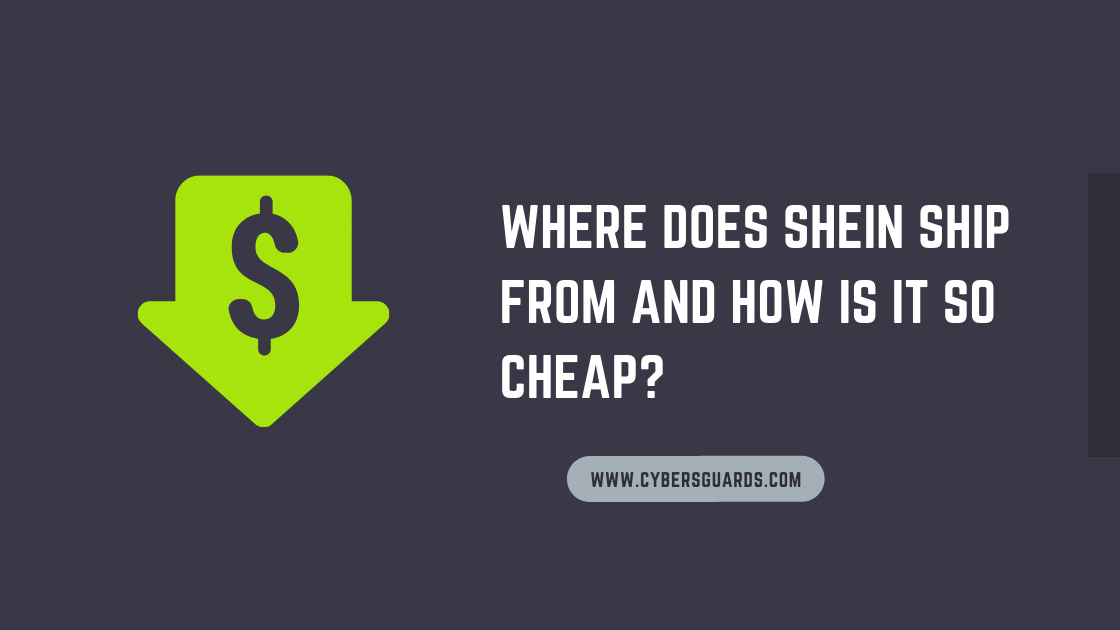In the world of online shopping, consumers are always on the lookout for stylish yet affordable options. One retailer that has caught the attention of many is Shein, known for its trendy clothing at remarkably low prices. Have you ever wondered how this fashion giant can provide such deals and where your stylish items are shipped from? Understanding the logistics behind Shein’s operations can provide insights into their business model and how they manage to balance cost with customer satisfaction.

Global Warehousing Strategy
Shein’s ability to offer inexpensive products is partly due to its innovative warehousing and distribution strategy. Unlike other retailers, Shein doesn’t rely on a central warehouse. Instead, they have multiple warehouses located strategically around the globe.
Detailed Steps:
- Shein utilizes warehouses in Asia, America, Europe, and the Middle East to cut down on shipping times and costs.
- When an order is placed, the item is shipped from the warehouse closest to the customer’s location.
- By dividing inventory across these warehouses, Shein can offer faster shipping to customers worldwide.
Summary:
This strategy allows customers to receive their orders more quickly while keeping shipping costs low. However, it may also pose a challenge in inventory management and can lead to discrepancies in stock availability.
Cost-Effective Manufacturing
One of the secrets behind Shein’s cheap prices is their cost-effective manufacturing processes. Shein primarily manufactures its products in China, where labor and production costs are lower compared to other parts of the world.
Detailed Steps:
- Shein partners with manufacturers who can produce clothing quickly and at a low cost.
- By producing in high volumes and keeping a close eye on fashion trends, they can make trendy items rapidly and efficiently.
- Shein’s quick turnover rate helps reduce storage costs and ensures new styles are continuously available.
Summary:
Cost-effective manufacturing enables Shein to pass savings onto the customer, offering them the latest styles at lower prices. However, such inexpensive production raises questions about the working conditions and quality of the items produced.
Just-in-Time Manufacturing
Shein employs a just-in-time (JIT) manufacturing approach, which means they produce items as they’re needed, rather than in large quantities that necessitate storage.
Detailed Steps:
- Shein uses real-time data to predict which styles and items will be in demand.
- Manufacturers are given orders based on these predictions, reducing waste and storage needs.
- This system allows Shein to adapt quickly to fashion trends and customer preferences.
Summary:
JIT manufacturing helps reduce overproduction and waste, which cuts down costs. However, this approach can lead to challenges if there’s a sudden unpredicted spike in demand for certain items.
Direct-to-Consumer Model
Shein operates on a direct-to-consumer model, which means that they sell products directly to customers without going through traditional retail channels.
Detailed Steps:
- By bypassing physical stores and selling online, Shein saves on costs such as rent, utilities, and staffing.
- They manage their entire customer journey—from production to purchase—to maintain control over their marketing and sales strategies.
- This model relies heavily on digital marketing and social media to reach potential buyers.
Summary:
The direct-to-consumer model offers Shein greater control and reduces overhead costs. However, the lack of physical presence means customers can’t try before they buy, potentially increasing return rates.
Economies of Scale
Due to Shein’s vast customer base and large order volume, they benefit from economies of scale, which reduce the cost per item.
Detailed Steps:
- As Shein grows and orders more products, they can negotiate better prices for materials and manufacturing.
- Bulk shipping also becomes more cost-effective.
- The savings from economies of scale can then be passed down to the consumer.
Summary:
Economies of scale help Shein keep prices low while expanding their business. On the flip side, this could potentially impact smaller competitors and contribute to market consolidation.
Minimum Advertising Costs
Shein keeps advertising costs to a minimum by leveraging social media and word-of-mouth marketing instead of traditional advertising methods.
Detailed Steps:
- They collaborate with influencers and use social media platforms to showcase their products.
- Customers are encouraged to share their purchases online, creating organic exposure.
- Shein also offers incentives, such as discounts, for customer reviews and referrals.
Summary:
Minimizing advertising costs allows Shein to offer competitive prices. Although effective, this strategy could be seen as over-reliant on external content creators and the shifting trends of social media platforms.
Data-Driven Decision Making
Shein utilizes advanced analytics to make data-driven decisions regarding inventory and design choices, which contributes to their cost-saving measures.
Detailed Steps:
- Customer data is analyzed to understand purchasing behaviors and preferences.
- This data informs product development and inventory selection, ensuring popular items are restocked and less popular ones are phased out.
- Continuous data analysis allows for a dynamic product catalog that aligns with customer desires.
Summary:
Data-driven decision making enables Shein to keep up with trends and customer wants without holding excess inventory, leading to lower costs. However, this reliance on data collection could raise privacy concerns among consumers.
Automated Systems
The use of automation in Shein’s operational processes streamlines both manufacturing and distribution, providing additional cost savings.
Detailed Steps:
- Automation in the production process reduces the need for manual labor.
- Automated warehousing and logistics systems improve efficiency and shorten delivery times.
- The use of technology helps minimize human error and streamlines the entire operational workflow.
Summary:
Automation allows Shein to operate efficiently and maintain low prices. The downside could be the potential reduction in human labor and a diminished focus on craftsmanship and quality control.
Simple Packaging
Shein opts for simple and cost-effective packaging options, which help keep shipping weights low and reduce material expenses.
Detailed Steps:
- Products are packaged in simple, lightweight materials that are inexpensive to produce.
- Shipping costs are reduced due to the lower overall weight of packages.
- Simple packaging practices also appeal to environmentally conscious consumers.
Summary:
Simplifying packaging is an easy way for Shein to cut costs and can be beneficial for the environment; yet, it could also lead to items becoming damaged during transit if not adequately protected.
No-Frills Customer Experience
Shein’s online platform is designed to be functional and user-friendly, avoiding the extra costs associated with a fancy shopping interface or customer loyalty programs.
Detailed Steps:
- The Shein website and app focus on a straightforward search-and-buy process, making it easy for customers to find and purchase items.
- Without the need for expensive interactive features or complex loyalty schemes, Shein saves on website development and management costs.
- A no-frills approach means that focus is kept on sales and turnover.
Summary:
Keeping the customer experience simple and efficient helps reduce overhead costs. However, some customers may miss the personal touch and loyalty rewards offered by other retailers.
Conclusion:
Shein has established itself as a dominant force in the online fast-fashion industry by implementing a well-thought-out business model that maximizes efficiency and minimizes costs. Their approach encompasses global warehousing, cost-effective manufacturing, a direct-to-consumer sales model, and several other strategies to keep their prices enticingly low. While their methods have certainly allowed them to offer competitive pricing, they shed light on the complexities and trade-offs of such a business strategy, raising questions about quality, sustainability, and labor practices. As consumers, understanding the underpinnings of Shein’s operations can lead to more informed shopping decisions.
FAQs:
Q: Can I choose which warehouse my Shein order ships from?
A: No, customers cannot choose the warehouse. Shein automatically dispatches orders from the warehouse closest to the customer’s location to optimize shipping times.
Q: Does Shein have physical stores or do they sell exclusively online?
A: Shein primarily sells its products online through its website and mobile app. They usually do not operate traditional brick-and-mortar stores.
Q: How does Shein’s just-in-time manufacturing impact their product quality?
A: Just-in-time manufacturing focuses on speed and cost-efficiency, which might sometimes result in variations in product quality. Consumers are encouraged to read reviews and product descriptions carefully before making a purchase.









